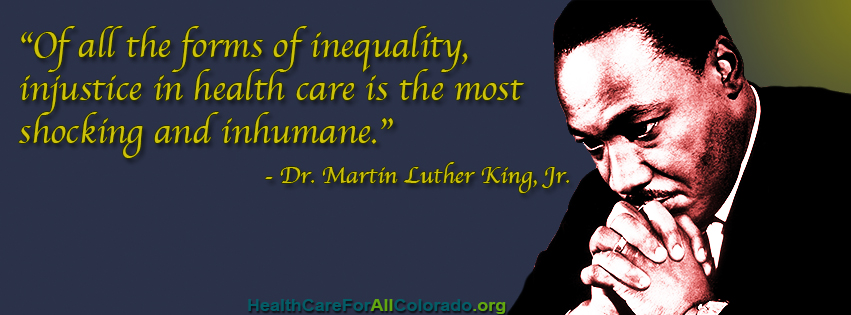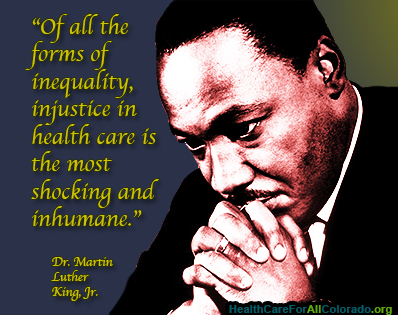Blog
Mayday: A Health Care System In Crisis
Our US Health Care System is not well. It is in a state of crisis. Today is May 1st, or "May Day" in many cultures. However, the term "mayday" is more applicable to our situation -- an international signal for distress.
While the ACA tried to patch things up, it didn't solve many core problems, and our path of unsustainability and irrational injustice continues unabated.
A Role Model, One Doctor's Path

President of Health Care for All Colorado
Back in the 1960’s when I first thought about becoming a pediatrician, I was in my mid-teens. I asked my own pediatrician, a woman who had known me since birth, if I could shadow her for a day. What an experience to watch her see patients at Brigham Women and Children’s Hospital in Boston, then follow her back to her elegant office in Brookline. Behind the closed doors of her private space, her desk was piled with charts and letters, and journals stacked on the floor and chairs. All at once, I didn’t feel so guilty about the state in which I left my bedroom that morning.
Good Friday Health Care Options? Go Bare or Go Broke
By Donna Smith
In America, we take our pound of flesh and our profits wherever we may find them. In our U.S. health care system, the opportunities to profit are plentiful no matter the pain, illness, worry or other suffering inflicted. For me, I now face a decision I have faced at other points in my life, but this time I am older and allegedly wiser.
This is a story played out all over America in homes where hard working people who have health concerns are faced with unimaginable choices. Just a few short weeks ago, I had a really good job with decent health insurance benefits. My husband is on Medicare (he’s older), and we also have purchased a really good supplemental (not an Advantage plan) for him. He has heart problems, and having good insurance is literally a matter of life and death for him. So, he is our priority and has been for the past 20-plus years in terms of health coverage.
A Bridge to Health Care for All
|
A Bridge to Health Care for All
Could Colorado use a similar method to fund universal health care to the method it is using to fund critical bridge repairs?
|
|
Visions of the Minneapolis disaster were still vivid for Coloradans when the report on our failing bridges was made public. The hundreds of millions needed to repair failing Colorado bridges far exceeded state financial resources because our economy was also collapsing. Colorado’s strict TABOR (Tax Payers Bill Of Rights) constitutional limitations on tax increases seemed to block any comprehensive approach to solving the bridge repair problem. The TABOR limitations also inhibit our efforts to create a system of universal access to health care in the Colorado and the consequences of perpetuating our failing health care system are even more serious than failing bridges.
The solution to funding the repair of bridges was found within the TABOR law itself. The law allows the Colorado to establish “enterprises” which function much like a business, receiving revenue from use fees and providing services to the users who pay the fees. TABOR enterprises must be established by the state legislature, must operate within specific restrictions and are governed by an appointed or elected board of directors. TABOR enterprises do not require a approval of Colorado voters in an election. In 2009 Colorado established the “Bridge Enterprise” and added new vehicle license registration fees to fund the replacement or repair of failing bridges. Initially drivers complained about the new license fees, however, the program has been highly successful. The Bridge Enterprise has also been opposed by the TABOR Foundation, the group who pushed for approval of the TABOR law in 1992. A law suit filed by the TABOR Foundation will be heard in May, 2013. Meantime, the Bridge Enterprise has been very successful. The 2012 Bridge Enterprise report to the state legislature reported that 72 bridges had been repaired or replaced, 22 were under construction and another 40 were in design or had design completed. The Bridge Enterprise had raised and expended over $130 million and, most importantly, our bridges are safer.
Colorado actually has hundreds of TABOR enterprises. They include the University of Colorado Medical Center, E-470 Toll Road, the University of Colorado and most other state universities and state colleges, and the Colorado Division of Wildlife. Without these important educational, health, transportation and environmental institutions Colorado would be quite a different place.
The Health Care for All Colorado Single-Payer Taskforce believes that the TABOR Enterprise approach may be a viable option for funding universal single-payer health care in Colorado. To make this a reality the Colorado Legislature will need to pass a bill to create a “Colorado Universal Health Care Enterprise”. The authorizing legislation will define the scope of services to be provided, the method of collecting fees to fund the health care services, and the makeup of the governing board. Individuals and employers will pay health care premiums into the health care enterprise fund and the fund will pay health care providers. The health care premiums should be about 20% lower in cost that current commercial health insurance premiums because of lower administrative costs and improved control of health care costs and better quality of health care services. Premiums will also be scaled to income and family size and every person in Colorado will have access to comprehensive health care services. A significant advantage of this approach is that the program can be administered as a part of the Colorado Department of Health Care Policy and Financing, just as the Bridge Enterprise operates within CDOT.
Safe bridges prevent accidents and save lives. Universal health care saves lives, saves money and results in a healthy and prosperous community.
The TABOR enterprise solution to funding bridge repairs could be Colorado’s “bridge to health care for all.”
Churning Isn’t Just for Butter Anymore
By Donna Smith, Executive Director, Health Care for All Colorado
It isn’t often anymore that I learn a new word in the health care system discussion, but this week I did. Churning. I was at a meeting here in Colorado where I have taken on my new role in advocating and administering for a publicly financed, universal, single-payer system with Health Care for All Colorado. And the definition of churning I learned is a sad commentary on a system that still allows access to care based on inequality of coverage that leaves so many people suffering and tens of thousands dying in America every year.
Churning is the policy wonk term for those who qualify and are covered by a public program like Medicaid and who then have access to a private insurance plan through a new job that offers it or through a family member’s coverage but who then lose that coverage and end up back on the public insurance for which they qualify. They churn. And they suffer.
Churning doesn’t happen in an orderly or smooth way. There is a person with health care needs churning. There may be weeks or even months during which that person has no coverage and therefore only the access that money can buy them, and we all know how far that will go. Sometimes there are children involved who churn with their parents. Kids with illness for which they need care can suffer during delays of approvals for both public and private plans. How do we explain churning to a child up in the middle of night with asthma symptoms or other problems? “Sorry, sweetheart, mommy is churning this week, and we do not have the money to buy that inhaler. Maybe the insurance will come through next week.”
Those who have tried to transition from one private plan to another due to a loss or change of jobs will understand. It is stressful to make these changes even under the best of circumstances. Imagine that policy wonks discuss ways to reduce churning from public to private and back to public plans again when there is a clear and equitable way to end it for good. Adopting a sensible, equitable, universal, publicly financed, single-payer – Medicare for all for life – system would end all of this awful churning and the need for policy wonks to study and find ways to reduce it.
So, I do not like the word for which I just learned a new connotation. Churning. Let’s end it. And while we’re at it, take a look at the most recent study results that reconfirm that this system of ours is among the worst, not the best, in the world. Those engaged in our public policy and budgetary decisions consider what broader sorts of economic “churning” does to our system.
From the article linked above: “Policymakers must recognize the potential implications of current decisions that have to be made about public health and social programmes that are currently in jeopardy because of fiscal concerns,” Woolf says.
“Understanding how cuts to those programmes might help balance budgets will probably exacerbate the country’s current health disadvantage – and make greater demands on the system later on. We need to help them understand the larger economic implications, if not the human toll.”
People are suffering while we have the capacity to stop the suffering. Our community values would have us end that suffering if it was at all possible, and it is definitely possible. We need the will to do so. Let’s get on with that work.
Martin Luther King, Jr. Day
On this day, we remember and pay tribute to the legacy of Dr. Martin Luther King, Jr., who spoke these simple, yet eloquent words:
"Of all the forms of inequality, injustice in health care is the most shocking and inhumane."
Feel free to use these images on Facebook:


